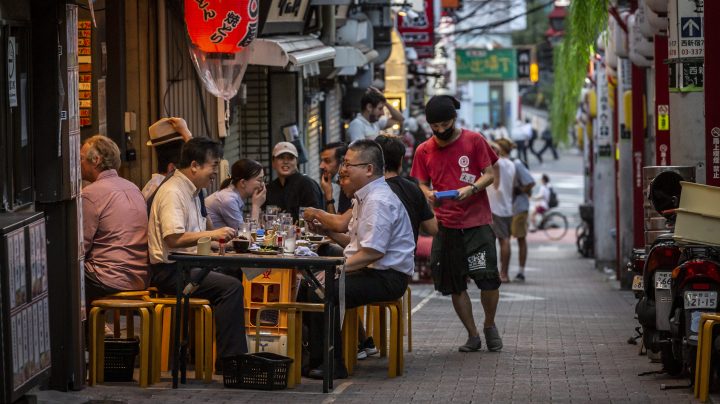
Japanese shocked by rising prices after decades of economic stagnation
Japanese shocked by rising prices after decades of economic stagnation

As a child growing up in Japan, I observed that prices rarely rose. My favorite lunch was always available for a 500 yen coin, or about $3.70 at the current exchange rate, and it remained that way until 2021. The same for shoes and other clothes — little changed. I was taught to save, save and save, and I was repeatedly warned that the value of our family home had collapsed in the 1990s, when the property market crashed. This painful financial loss meant my parents were never able to sell their house or upgrade it.
When prices for everyday items don’t increase, people tend not to increase their spending. Companies, in turn, respond by not raising salaries for their workers, which constrains consumer demand and prices further. When you cannot get a pay raise, you don’t rush out to go shopping very often. Taken together, this slows a whole country’s economic growth — a vicious cycle that Japan has been trapped in for decades.
While many parts of Asia grew richer, Japan’s wealth stagnated. The country’s per-capita gross domestic product — or economic output per person — has remained stuck at the same level since the 1990s. By 2010, China had overtaken it as the world’s second-biggest economy.
For decades, the country’s central bank has tried to stimulate growth, to get Japanese to “spend more, invest more. The wage goes up and the price goes up in tandem moderately,” explained Nobuko Kobayashi, a partner with EY-Parthenon.
In April, consumer prices finally rose enough to hit the Bank of Japan’s 2% inflation target. But that had nothing to do with domestic economic policy; it was driven largely by a global increase in prices for raw materials and energy, pushed higher by external factors like the pandemic and the war in Ukraine.
This is not good news, though. Kobayashi warned that it could mark “the start of bad inflation because wages have not gone up yet.” In fact, people’s average salaries have hardly risen for over three decades.
While many governments have been battling rising prices and a higher cost of living post-COVID, it comes as a shock to Japanese shoppers, who have been used to decades of stable prices.
When the price of Japan’s everyday snack, Umaibo — which was always available for 10 yen (about 7½ cents) since its creation 43 years ago — went up by 20%, it sent a shudder through the nation. In a society that believes in sharing social burdens, increasing prices has become something of a cultural taboo. So much so that Yaokin, the company that makes the popular snack, had to launch an ad campaign explaining the decision.

But it was inevitable, and one by one, everything from mayonnaise to beer has become more expensive. According to Teikoku Databank, prices for more than 10,000 food items are set to go up an average of 13% this year.
Central bank dilemma
And here Japan has a unique problem: Central banks across the rest of the world have reacted to soaring food and fuel prices by raising interest rates, but the Bank of Japan cannot.
When there is a gap in interest rates between Japan and other major economies like the U.S., the Japanese currency sharply weakens. In just a few months this year, it lost over 13% of its value. A weaker yen means that imported items — crucially oil and gas — cost more, while a strong yen makes Japanese products more expensive and therefore less competitive to sell abroad.
“Consumers are not accustomed to accepting inflation,” said Takeshi Niinami, the chief executive of Suntory Holdings, known for Japanese whiskies Yamazaki, Hibiki and Hakushu, which also sells beer and nonalcoholic beverages, like bottled water and coffee.

The company recently announced a price hike for the majority of its products in October to give itself time to discuss the raise with its distributors. Niinami blames the decision on global supply chain issues caused by the pandemic and China’s recent COVID lockdowns.
“Overall, it has been accepted. But there is still a challenge from big retailers,” he said.
Part of the rationale for promoting inflation in the Japanese economy is to push wages higher. “But it’s difficult to increase productivity all of a sudden. We have so many peers in one industry, so we have to consolidate.”
Niinami said Japan also needs to create new sectors like green innovation or expand health care to create more jobs and boost average salaries. He also hopes the government will do more to attract foreign investment. But all that will take time, and Japan has been grappling with these issues for decades.
One silver lining of a weak yen could be an influx of foreign tourists spending money in Japan, but the borders are only starting to open after COVID. With prices likely to stay high globally, Japan may be running out of time to break the cycle before everyday consumers feel the pain.
There’s a lot happening in the world. Through it all, Marketplace is here for you.
You rely on Marketplace to break down the world’s events and tell you how it affects you in a fact-based, approachable way. We rely on your financial support to keep making that possible.
Your donation today powers the independent journalism that you rely on. For just $5/month, you can help sustain Marketplace so we can keep reporting on the things that matter to you.

















